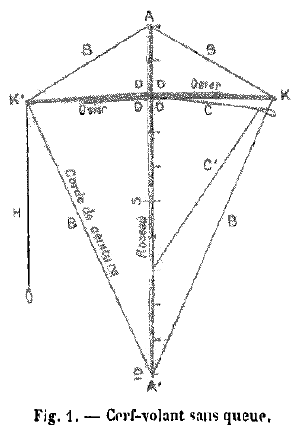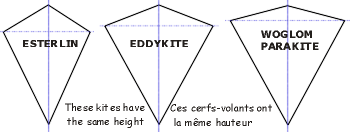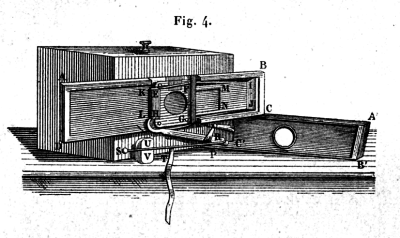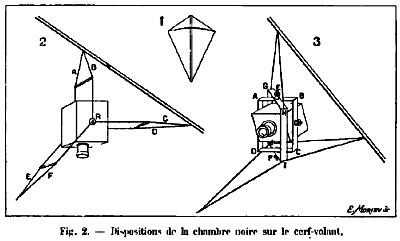When
Batut begun to think about kite aerial photography,
it was an unknown world. He entered in this adventure as
a pioneer. At each step he had to create the tools which
will be the most appropriate. Not only the combination between
kite design, camera technical features, photographic treatment
and kite flying had to be performed, but in each topic major
technical feasibility had to be improved.
For
this invention the major items needed were:
About KITING:
|
a kite
a kite line
A kap methodology
|
About
PHOTOGRAPHY |
a camera
a film
a remote trigger
|
|
|
The CHALLENGE.
In the 1880's many aerial photography
from manned ballon ascension were unsucceessful. Kite aerial
photography was more challenging.
Except one kite created
2 years before, available kite designs didn't have the required
features.
The lines were heavy and
not reliable. It had to be selected carefully. Steel wire
was used but required special winches which couldn't be
easily handled and moved.
There was no kiting methodology
and kite scientific applications started efficiently only
a few years before.
Cameras were heavy, the
shutter too slow and the photographic surfaces not sensitive
enough. Lenses had small angle of view. The wide angle
lenses didn't had aperture open enough.
Remote release systems had
to be adapted. Most of the modern ones, electric release,
clock timers, were heavy.
|
- KITE
-
A.
Batut checked all available kite designs and
after some benchmark choose the "cerf-volant
sans queue", the tailless kite of J. Esterlin.
The
drawing have been published in La Nature weekly
magazine dated February 28th, 1887. It's a bowed
diamond kite.
|

|
A. Batut customized
it. The frame have been modified; even it flies tailless,
A. Batut added a fuzzy tail to dampen the moves of the kite.
A. Batut have also flown two as a train. The dimensions
were 2,5 m high, 1,75 m width, weighting 1,8 kg First made
of paper, kite was later made of clothe. When it was created,
the Esterlin's diamond kite provided a higher line angle,
a higher pull and an increased stability compared to other
kites. It was the best kite with qualities required for
kap, giving to Batut the more chance for success.
-
|
|
In the European and American countries J.
Esterlin's creation was the first modern kite and the first
dihedral kite. Later, in 1891, Eddy (USA) started experimenting
tailless kites and after looking at the Malay kite he ended
to the Eddykite in 1894. At the same period Woglom (USA) also
reviewed oriental kites and from them designed the tailless
bowed Parakite
which he used as train. Then the Levitor of Baden F. S. Powell
(England) and the cellular kite of Hargrave (Australia) were
created.

The above outline of diamond kites have all
the same length of spine.
About Esterlin's kite read P. Mazieres' paper
in NCB n° 137 issued in 2007. |
- KITE LINE
-
- A. Batut recommended a hemp line.
He choose the lightest one with enough resistance, Ø
3.5mm. He also designed and recommended a reel made of wood
for easy manoeuvre.
- He set a rubber between the bridle
and the line to dampen the gusts of the wind on the line.
He used wooden olive bead for fast attachment of kite line.
-
|
|
A. Batut didn't ignored the use of steel wire preferred by
many kiters who performed experimentations in France especially
for cloud electricity. But he didn't recommended steel
wire as "such a wire is comparable to a sharp blade,
capable to cause severe wounds in case of accidents"
Note: The line and the rubber killed many vibrations
which are unavoidable with steel wire. |
- KAP
METHODOLOGY
-
- There are many details in the
way A. Batut proceeded that let aware he had carefully imagined
and organized it. Let's see some of them.
- - record the
attack angle of the kite.
- - procedure
to launch a kite in calm winds
- - reach a higher
altitude with a second kite
- - record the
height of the kite with a photograph of index of aneroid
barometer
- - how to be
positioned to aim the target?
- - how to stabilize
the kite when shooting: see opposite
- - display a
paper strip to see when it's released
-
|
|
A. Batut gave full description
of all details of his method in his book published early
1890: La photographie aérienne par cerf-volant.
He explained how to practice a
safe launching
He accounted for checking the time
of shutter release and "walk downwind with sufficient
speed so that the kite has a tendency to come down. Under
these conditions, it will recover its necessary stability
to allow the obtention of a photograph."
He also provided updated informations
in a paper published in La Nature, January 1897:
- Note: Because of the line and its easy anchoring,
it was easy to move for targeting the picture and compensate
for wind changes.
|
- CAMERA
-
A. Batut fabricated
a body to have a light and rigid camera. He described how
to make it.
The lens was
a Steinhell aplanat 166mm focal length and used at its maximum
aperture. It gives few distorsions. Batut put it inside
the body so it was fully protected.
The main problem
was the shutter speed. Most cameras had shutters speeds
between 1/10 to a few seconds. During this period appeared
the "instantanés" which were pictures shot
at higher speeds 1/10 to 1/50s. Only special cameras had
shutters up to 1/100 to 1/150 s however the measure of the
speed by the makers was not trusted.
Arthur Batut
overcame the problem by designing, making and testing himself
the shutter. It was set outside the camera, in front of
the lens. Anything else with a shutter speed not faster
than 1/50s could only get blurred photographs
In the 1890's
there was a considerable improvement in the photographic
industry with photographic surfaces more sensitive. Thus
new shutters were fabricated with speeds up to 1/250s.
From there A.
Batut improved his equipment and used a rotating shutter.
He also modified the rig hanging the camera.
Here are two
drawings showing the camera and its evolution. The upper
figure from his book early 1890 and the lower one from his
paper in La Nature in January 1897.
-
|
-
|
First Batut's
design shutter
-
Batut's improvements
-
|
- PLATES / FILM
-
Photographic
surfaces were not very sensitive. Apart from glass plates,
the sensitive emulsion could be spreaded on paper, or on
soft plates.
A. Batut
used both. Film plates are lighter than glass plates, but
were difficult to maintain flat. Batut taped them on the
bottom face of the camera.
Most of photographers
had to develop themselves. A. Batut was a keen photographer
with a large experience. He knew how to get the best of
it.
-
|
-
|
-
-
The low sensitivity of photographic
emulsion required long exposure. Most photographs were on
glass plates, some on soft plates or directly on paper.
The roll film was not yet in use. George Eastman created
its soft plates in 1880 and the film in 1885. Because of
the technique there was no enlargements and thus dimensions
of the camera and of the photographic surface were large.
It must be noted that color picture
was only experimental.
|
- REMOTE TRIGGER
-
A. Batut had
the choice between many available techniques but most of
them were heavy. As for the other items, A. Batut preferred
the lightest solution. He took the lightest and the unfailing
one: the time delay wick, or match. He made tests and the
time of the release was measured and checked.
-
|
-
|
-
-
-
Until the electronic superceded
all other devices, the match have been used by generations
of kapers, as Batut said: " simple, even primitive,
invariably functionning at the precise instant which we
previously set."
|
KITE
AERIAL PHOTOGRAPHY INVENTION
Arthur
BATUT has really
pioneered kap techniques and is the inventor of kite aerial photography.
The first
known photograph is one of the two photographs he sent to
Gaston Tissandier in August 1888.
Then,
the first publication about at kite aerial photograph is
Tissandier's chronicle in the French weekly magazine La
Nature August 25th.
Arthur
Batut improved fast his technique. The picture of Labruguière
dated 1889, March 29th and published in his book is
displayed here. The kite line is seen at the bottom of
the picture.
There
is no other substantiated evidence of kap invention. Any
kind of allegation of invention before 1888 is simply historically
unfounded.
-
|
|
FIRST
PHOTOGRAPH
The first
known kite aerial picture was shot by Arthur Batut in May
1888. It is a perspective picture 8x10 cm.and, as said Tissandier,
still imperfect.
This photograph
is preserved in the ESPACE ARTHUR BATUT in Labruguière,
Tarn, France. It has been titled by Batut " Le chemin
et le ruisseau", the track and the brook. It shows
also tree line and hay stacks. The hay-making in this area
being from end of April to end of June, the date of the
photograph is prooved genuine. It is the world first kite
geomorphology and agricultral survey aerial photograph.
HISTORICAL
AUTHENTICITY
-
All informations
and datas provided in this page are coming from historical
documents and from informations distributed by Foundations
preserving historical knowledge. It is not based on unverified
citations from other authors.
The truthfulness
of these informations is established as kap history.
|
- SHORT BIBLIOGRAPHY
-
¤
LA NATURE papers issued 1887, February 28th; 1888, August
25th; 1889, March 23rd; 1890, March 15th; 1891, September
26th; 1897, January 2nd.
-
¤
KAPWA magazine, July 1986
-
-
-
-
A recommended
historical survey on kite and kap aerial photography is
Andrea Casalboni's pages.
|
-
|
Arthur
BATUT's PRIORITY
There is
no historical doubt about Arthur Batut's priority on Kite
Aerial Photography invention. There are historical documents,
facts reported by witnesses, and many preserved photographs
and apparatus to substantiate it.
It is well
known that an allegation of E. Douglas Archibald in 1897
has been spreaded since 1967. In 1986 KAPWA magazine have
published an historical investigation showing that this
claim had not been verified and demonstrating it was a fake.
I have
done a new analysis of the historical documents. This survey
establishes without any doubt Arthur Batut's priority and
invention. It includes all references and extracts of historical
documents. Download this survey.
-
|



